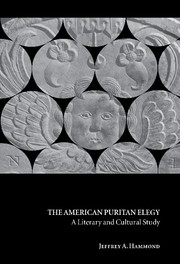Book contents
- Frontmatter
- Contents
- Preface
- Acknowledgments
- Introduction
- Chapter 1 Monuments enduring and otherwise
- Chapter 2 Toward an anthropology of Puritan reading
- Chapter 3 Weep for yourselves: the Puritan theology of mourning
- Chapter 4 This potent fence: the holy sin of grief
- Chapter 5 Lord, is it I?: Christic saints and apostolic mourners
- Chapter 6 Diffusing all by pattern: the reading of saintly lives
- Epilogue: Aestheticizing loss
- Notes
- Works cited
- Index
Chapter 6 - Diffusing all by pattern: the reading of saintly lives
Published online by Cambridge University Press: 22 September 2009
- Frontmatter
- Contents
- Preface
- Acknowledgments
- Introduction
- Chapter 1 Monuments enduring and otherwise
- Chapter 2 Toward an anthropology of Puritan reading
- Chapter 3 Weep for yourselves: the Puritan theology of mourning
- Chapter 4 This potent fence: the holy sin of grief
- Chapter 5 Lord, is it I?: Christic saints and apostolic mourners
- Chapter 6 Diffusing all by pattern: the reading of saintly lives
- Epilogue: Aestheticizing loss
- Notes
- Works cited
- Index
Summary
Puritans brought death and commemoration into the legal and evangelical dispensations of Scripture, with Christ as an articulating center. Grief, like the Word itself, invoked a dichotomy of fear and hope that was reinforced by the deceased, commemorated as a double icon of mortality and glory. Proper mourning was also twofold, a process that led from self-centered tears to a selfless witnessing to the deceased's victory. Elegy regularized this process by offering a textual template, in the deceased as well as in the poem, capable of containing death's disruption. By assimilating the dead to the story of salvation, the elegiac ritual transformed them into permanent “texts” of piety that were, like all Puritan texts, inseparable from the defining metatext of Scripture. Commemorated as anthropomorphic extensions of the Word, departed saints performed the same work as the two Testaments, encouraging the same interplay of text and reader that characterized an engaged reading of Scripture. As embodiments of the biblical text, the dead were subsumed within the text of the poem, which was in turn assimilated by readers who thereby learned to see themselves in biblical terms. With this redistribution of the deceased's piety throughout the community, personal loss was rewritten as redemptive gain.
As Increase Mather proclaimed in a biography of his father Richard, “The Writing and Reading of the Lives of Worthy Ones, hath been by some accounted amongst the most profitable works of men under the Sun” (1).
- Type
- Chapter
- Information
- The American Puritan ElegyA Literary and Cultural Study, pp. 169 - 204Publisher: Cambridge University PressPrint publication year: 2000

